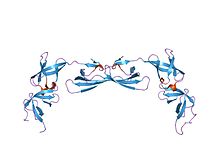Elongation factor P
| Elongation factor P (EF-P) KOW-like domain | |||||||||
|---|---|---|---|---|---|---|---|---|---|
 crystal structure of translation initiation factor 5a from pyrococcus horikoshii | |||||||||
| Identifiers | |||||||||
| Symbol | EFP_N | ||||||||
| Pfam | PF08207 | ||||||||
| Pfam clan | CL0107 | ||||||||
| InterPro | IPR013185 | ||||||||
| PROSITE | PDOC00981 | ||||||||
| |||||||||
| Elongation factor P (EF-P) OB domain | |||||||||
|---|---|---|---|---|---|---|---|---|---|
 crystal structure of translation elongation factor p from thermus thermophilus hb8 | |||||||||
| Identifiers | |||||||||
| Symbol | EFP | ||||||||
| Pfam | PF01132 | ||||||||
| Pfam clan | CL0021 | ||||||||
| InterPro | IPR001059 | ||||||||
| PROSITE | PDOC00981 | ||||||||
| CDD | cd04470 | ||||||||
| |||||||||
| Elongation factor P, C-terminal | |||||||||
|---|---|---|---|---|---|---|---|---|---|
 crystal structure of translation elongation factor p from thermus thermophilus hb8 | |||||||||
| Identifiers | |||||||||
| Symbol | Elong-fact-P_C | ||||||||
| Pfam | PF09285 | ||||||||
| InterPro | IPR015365 | ||||||||
| SCOP2 | 1ueb / SCOPe / SUPFAM | ||||||||
| CDD | cd05794 | ||||||||
| |||||||||
In molecular biology, elongation factor P is a prokaryotic protein translation factor required for efficient peptide bond synthesis on 70S ribosomes from fMet-tRNAfMet.[1] It probably functions indirectly by altering the affinity of the ribosome for aminoacyl-tRNA, thus increasing their reactivity as acceptors for peptidyl transferase.
Elongation factor P consists of three domains:
- An N-terminal KOW-like domain
- A central OB domain, which forms an oligonucleotide-binding fold. It is not clear if this region is involved in binding nucleic acids[2]
- A C-terminal domain which adopts an OB-fold, with five beta-strands forming a beta-barrel in a Greek-key topology[2]
eIF5A is the eukaryotic homolog of EF-P.
Function
It has been suggested that after binding of the initiator tRNA to the P/I site, it is correctly positioned to the P site by binding of EF-P to the E site.[3]
References
- ^ Aoki H, Adams SL, Turner MA, Ganoza MC (1997). "Molecular characterization of the prokaryotic efp gene product involved in a peptidyltransferase reaction". Biochimie. 79 (1): 7–11. doi:10.1016/S0300-9084(97)87619-5. PMID 9195040.
- ^ a b Hanawa-Suetsugu K, Sekine S, Sakai H, Hori-Takemoto C, Terada T, Unzai S, Tame JR, Kuramitsu S, Shirouzu M, Yokoyama S (June 2004). "Crystal structure of elongation factor P from Thermus thermophilus HB8". Proc. Natl. Acad. Sci. U.S.A. 101 (26): 9595–600. doi:10.1073/pnas.0308667101. PMC 470720. PMID 15210970.
- ^ Leaps in Translational Elongation Science (2009) 326, 677.
